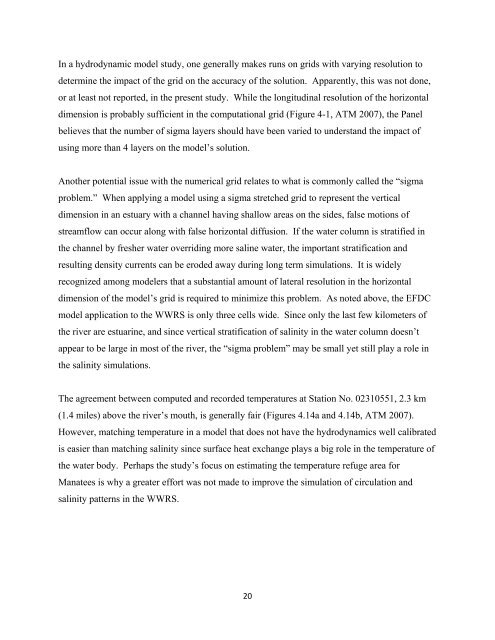Weeki Wachee River System Recommended Minimum Flows and ...
Weeki Wachee River System Recommended Minimum Flows and ...
Weeki Wachee River System Recommended Minimum Flows and ...
Create successful ePaper yourself
Turn your PDF publications into a flip-book with our unique Google optimized e-Paper software.
In a hydrodynamic model study, one generally makes runs on grids with varying resolution to<br />
determine the impact of the grid on the accuracy of the solution. Apparently, this was not done,<br />
or at least not reported, in the present study. While the longitudinal resolution of the horizontal<br />
dimension is probably sufficient in the computational grid (Figure 4-1, ATM 2007), the Panel<br />
believes that the number of sigma layers should have been varied to underst<strong>and</strong> the impact of<br />
using more than 4 layers on the model’s solution.<br />
Another potential issue with the numerical grid relates to what is commonly called the “sigma<br />
problem.” When applying a model using a sigma stretched grid to represent the vertical<br />
dimension in an estuary with a channel having shallow areas on the sides, false motions of<br />
streamflow can occur along with false horizontal diffusion. If the water column is stratified in<br />
the channel by fresher water overriding more saline water, the important stratification <strong>and</strong><br />
resulting density currents can be eroded away during long term simulations. It is widely<br />
recognized among modelers that a substantial amount of lateral resolution in the horizontal<br />
dimension of the model’s grid is required to minimize this problem. As noted above, the EFDC<br />
model application to the WWRS is only three cells wide. Since only the last few kilometers of<br />
the river are estuarine, <strong>and</strong> since vertical stratification of salinity in the water column doesn’t<br />
appear to be large in most of the river, the “sigma problem” may be small yet still play a role in<br />
the salinity simulations.<br />
The agreement between computed <strong>and</strong> recorded temperatures at Station No. 02310551, 2.3 km<br />
(1.4 miles) above the river’s mouth, is generally fair (Figures 4.14a <strong>and</strong> 4.14b, ATM 2007).<br />
However, matching temperature in a model that does not have the hydrodynamics well calibrated<br />
is easier than matching salinity since surface heat exchange plays a big role in the temperature of<br />
the water body. Perhaps the study’s focus on estimating the temperature refuge area for<br />
Manatees is why a greater effort was not made to improve the simulation of circulation <strong>and</strong><br />
salinity patterns in the WWRS.<br />
20
















